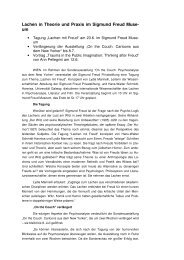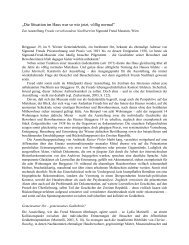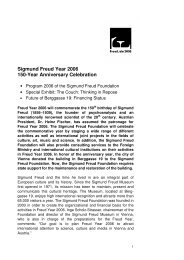Sigmund Freud-Museum | Newsletter - Sigmund Freud Museum Wien
Sigmund Freud-Museum | Newsletter - Sigmund Freud Museum Wien
Sigmund Freud-Museum | Newsletter - Sigmund Freud Museum Wien
Create successful ePaper yourself
Turn your PDF publications into a flip-book with our unique Google optimized e-Paper software.
children’s eyes) were their pet dogs and cats, people were special because they had reason. The<br />
Aristotelian definition of man as a rational animal made sense even for the youngest children. But<br />
when, in the 1980s, it seemed to be the computers who were the nearest neighbors, children’s approach<br />
to the problem changed. Now, people were special not because they were rational animals but because<br />
they were emotional machines. So, in 1983, a ten-year-old told me: “When there are the robots that are<br />
as smart as the people, the people will still run the restaurants, cook the food, have the families; I guess<br />
they’ll still be the only ones who’ll go to Church.”<br />
Now in a world in which machines present themselves as emotional, what is left for us?<br />
One woman’s comment on AIBO, Sony’s household entertainment robot, startles in what it might<br />
augur for the future of person-machine relationships: “[AIBO] is better than a real dog. ... It won’t do<br />
dangerous things, and it won’t betray you. ... Also, it won’t die suddenly and make you feel very sad.”<br />
In Ray Bradbury’s story, “I sing the body electric,” a robotic, electronic grandmother is unable to win<br />
the trust of the girl in the family, Agatha, until the girl learns that the grandmother, unlike her recently<br />
deceased mother, cannot die. In many ways throughout the story we learn that the grandmother is<br />
actually better than a human caretaker – more able to attend to each family member’s needs, less<br />
needy, with perfect memory and inscrutable skills – and most importantly – not mortal.<br />
Mortality has traditionally defined the human condition; a shared sense of mortality has been the basis<br />
for feeling a commonality with other human beings, a sense of going through the same life cycle, a<br />
sense of the preciousness of time and life, of its fragility. Loss (of parents, of friends, of family) is part<br />
of the way we understand how human beings grow and develop and bring the qualities of other people<br />
within themselves.<br />
The possibilities of engaging emotionally with creatures that will not die, whose loss we will never<br />
need to face, presents dramatic questions that are based on current technology – not issues of whether<br />
the technology depicted in A.I. could really be developed.<br />
The question, “What kinds of relationships is it appropriate to have with machines?” has been explored<br />
in science fiction and in technophilosophy. But the sight of children and the elderly exchanging<br />
tenderness with robotic pets brings science fiction into everyday life and technophilosophy down to<br />
earth. In the end, the question is not just whether our children will come to love their toy robots more<br />
than their parents, but what will loving itself come to mean?<br />
Conclusion: Toward the Future<br />
of the Computer Culture<br />
Relational artifacts are being presented to us as companionate species at the same time that other<br />
technologies are carrying the message that mind is mechanism, most notably psychopharmacology. In<br />
my studies of attitudes toward artificial intelligence and robotics, people more and more are<br />
responding to a question about computers with an answer about psychopharmacology. Once Prozac<br />
has made someone see his or her mind as a biochemical machine it seems a far smaller step to see the<br />
mind as reducible to a computational one. Twenty years ago, when my student turned a <strong>Freud</strong>ian slip<br />
into an information-processing error, it was computational models that seemed most likely to spread<br />
mechanistic thinking about mind. Today, psychopharmacology is the more significant backdrop to the<br />
rather casual introduction of relational artifacts as companions, particularly for the elderly and for<br />
children.<br />
The introduction of these objects is presented as good for business and (in the case of children) good<br />
for “learning” and “socialization.” It is also presented as realistic social policy. This is the “robot or<br />
nothing” argument. (If the old people don’t get the robots, they certainly aren’t going to get a pet.)<br />
Many people do find the idea of robot companions unproblematic. Their only question about them is,<br />
“Does it work?” By this, they usually mean, “Does it keep the elderly people/children quiet?” There<br />
are, of course, many other questions. To begin with, (even considering) putting artificial creatures in<br />
the role of companions to our children and parents raises the question of their moral status.<br />
Already, there are strong voices that argue the moral equivalence of robots as a companion species.<br />
Kurzweil talks of an imminent age of “spiritual machines,” by which he means machines with enough<br />
self-consciousness that they will deserve moral and spiritual recognition (if not parity) with their<br />
human inventors.11 Computer “humor,” which so recently played on anxieties about whether or not<br />
people could “pull the plug” on machines, now portrays the machines confronting their human users









